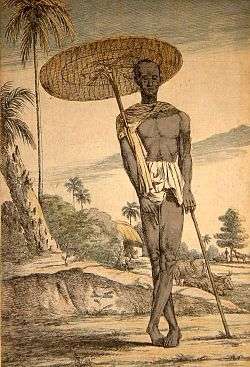Gowari


Gowari, alternatively known as Gavli, Gowlan or Gowli, are a pastoral caste predominantly living in Maharashtra, Madhya Pradesh, Chhattisgarh and Goa states of India. The word Gavli means a milkmen or herdsmen in the Marathi language, and refers to a number of communities that practice, or at one time practiced pastoralism in western India.
Distribution
The maximum concentration of their population is in the districts of Nagpur and Gondia[1] where they are around 50,000 to 100,000.
In Maharashtra
In Maharashtra, the Gavli community have four sub-divisions, the Yadav or Ahir Gavli, Yadavanshi Gavli, Nandvanshi Gavli and Lingayat Gavli. Each of these groups is of a distinct origin, and do not intermarry, and have their own particular customs and traditions.[2]
The Yadav Ahir Gavli
The Ahir are one of the four sub-divisions of the Gavli found in Maharashtra, and are found throughout the state. They are also known as Ahire, Golkar, Goalar, and Rawat. According to their tradition following a communal riot between Hindus and Muslims, they left their ancestral village of Kharpa in Kannauj District of Uttar Pradesh. The community continue speak Hindi among themselves, but most also speak Marathi. They have been granted other backward caste status in Maharashtra. Historically, the community was involved in selling of milk.[3]
Yadav Gavli Association
The first Yadav Gavli Association was founded in 1903, and in the early 1920s it petitioned the Southborough Committee to recognise the caste as Maratha. In support of their claim, the Yadav Gavli cited their legendary descent from Krishna, a history of Yadav kings in North India, Gujarat, and the Deccan, their Kshatriya practices, and their frequent service in the British military, to include the Maratha regiments.[4]
In Gujarat
In Gujarat, the Gavli are an immigrant community, having immigrated in the 18th Century from Maharashtra. They are found mainly in Rajkot and Baroda districts. Most of the community now speak Gujarati, although a significant number still understand Marathi. Marital ties are still maintained with Gavli communities in Maharashtra. The Gavli community is further divided into a number of exogamous clans such as the Hiranwar, Hajari, Bania, Fulsunge and Phenwar. Each of these clans maintains their own tribal deities, such the Bania Gavli, who worship Ajottmata. Historically, the Gavli were cattle herders, although they maintained a distance from Gujarati pastoral communities such as the Ahir and Charan. Many have given up their traditional occupation, and begun to settle down in towns and cities.[5]
In Goa
Goan Gavlis are generally vegetarians and speak Konkani. Their localities are called as Gavḷhīvāḍo, such places are found in many places in Goa.[2][6]
Gowari stampede

There was a stampede during a protest in Nagpur on 23 November 1994 in which 114 people from the Gowari community were killed and more than 500 were injured.
A monument, the Gowari Shaheed Smarak, has been built in Nagpur near Zero Milestone,[7] (the geographical centre of India) to commemorate those who died in this tragedy. Also the nearby flyover (Sitabuldi area, Nagpur) has been named Adivasi Gowari Shaheed flyover.
See also
- Dhangar, another herdsman caste
- Ahir
- Yadav
- Konar (caste)
References
- ↑ "सर्व्हर दोष !" (PDF). Maharashtra.gov.in. Retrieved 2015-03-06.
- 1 2 People of India Maharshtra Volume XXX Part Three edited by B.V Bhanu, B.R Bhatnagar, D.K Bose, V.S Kulkarni and J Sreenath pages 2067-2072
- ↑ People of India Maharshtra Volume XXX Part Three edited by B.V Bhanu, B.R Bhatnagar, D.K Bose, V.S Kulkarni and J Sreenath pages 58- 64
- ↑ Christophe Jaffrelot (2003). India's silent revolution: the rise of the lower castes in North India. Columbia University Press. pp. 163–. ISBN 978-0-231-12786-8. Retrieved 31 May 2011.
- ↑ People of India Gujarat Volume XXII Part One edited by R.B Lal, S.V Padmanabham & A Mohideen page 393 to 396 Popular Prakashan
- ↑ Singh, Kumar Suresh (1993). People of India: Goa. Anthropological Survey of India,. ISBN 81-7154-760-5. ISBN 9788171547609.
- ↑ Archived August 16, 2010, at the Wayback Machine.